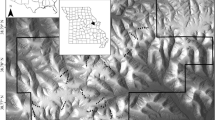Summary
A series of experiments was conducted to test the hypothesis that habitat selection by the salamanders Desmognathus monticola and Desmognathus quadramaculatus is influenced differently by interspecific interference than by intraspecific interference. Individuals of neither species were influenced differently by the presence of heterospecifics than by the presence of conspecifics in their activity away from cover sites, in selection of different substrate moisture levels, in selection of different substrate textures, nor in selection of microhabitats relative to the streambed. Both species generally selected substrates with the highest moisture and the coarsest texture. Selection of different cover sizes by D. monticola depended on microhabitat, with larger rocks being selected most frequently when salamanders were farther from the streambed. D. quadramaculatus was seldom found away from the streambed and did not discriminate among the cover sizes available. The strong affinity of D. quadramaculatus for streambed microhabitat, compared with the much more variable microhabitat selection of D. monticola, resulted in spatial separation of individuals of the two species most of the time. Results of this study do not support the hypothesis that interspecific inference is more important than intraspecific interference in the microhabitat distributions of D. monticola and D. quadramaculatus.
Similar content being viewed by others
References
Bishop YMM, Fienberg SE, Holland PW (1975) Discrete multivariate analysis. Massachusetts Institute of Technology Press, Cambridge
Brandon RA, Huheey JE (1971) Movements and interactions of two species of Desmognathus (Amphibia, Plethodontidae). Amer Mid Natur 86:86–92
Colwell RK, Fuentes ER (1975) Experimental studies of the niche. Ann Rev Ecol Syst 6:281–310
Connell JH (1980) Diversity and the coevolution of competitors, or the ghost of competition past. Oikos 35:131–138
Conover WJ (1971) Practical nonparametric statistics. New York: John Wiley and Sons
Dixon WJ (ed) (1981) BMDP Statistical Software. Berkeley: University of California Press
Fraser DF (1976) Empirical evaluation of the hypothesis of food competition in salamanders of the genus Plethodon. Ecology 57:459–471
Hairston NG (1980a) Species packing in the salamander genus Desmognathus: what are the interspecific interactions involved? Amer Natur 115:354–366
Hairston NG (1980b) The experimental test of an analysis of field distributions: competition in terrestrial salamanders. Ecology 61:817–827
Hairston NG (1980c) Evolution under interspecific competition: field experiments on terrestrial salamanders. Evolution 34:409–420
Hairston NG (1983) Alpha selection in competing salamanders: experimental verification of an a priori hypothesis. Amer Natur 122:105–113
Jaeger RG (1971) Competitive exclusion as a factor influencing the distributions of two species of terrestrial salamanders. Ecology 52:632–637
Jaeger RG (1972) Food as a limited resource in competition between two species of terrestrial salamanders. Ecology 53:535–546
Keen WH (1982) Habitat selection and interspecific competition in two species of plethodontid salamanders. Ecology 63:94–102
Keen WH (1984) Influence of moisture on the activity of a plethodontid salamander. Copeia 1984:684–688
Keen WH, Sharp S (1984) Responses of a plethodontid salamander to heterospecific and conspecific intruders. Anim Behav 32:58–65
Krzysik AJ (1979) Resource allocation, coexistence, and the niche structure of a streambank salamander community. Ecol Monogr 49:173–194
Maple WT (1974) An analysis of competition avoidance mechanisms in three desmognathine salamander species (Amphibia: Caudata). PhD Thesis. Kent State University, Ohio
Means DB (1975) Competitive exclusion along a habitat gradient between two species of salamanders (Desmognathus) in western Florida. J Biogeog 2:253–263
Morse DH (1974) Niche breadth as a function of social dominance. Amer Natur 108:818–830
Organ JA (1961) Studies of the local distribution, life history, and population dynamics of the salamander genus Desmognathus in Virginia. Ecol Monogr 31:189–220
Schoener TW (1974) Resource partitioning in ecological communities. Science 185:27–39
Schoener TW (1983) Field experiments on interspecific competition. Amer Natur 122:240–285
Wilder IW (1913) The life history of Desmognathus fusca. Biol Bull 24:251–343
Wood JT, Wood FE (1955) Notes on the nests and nesting of the Carolina Mountain dusky salamander in Tennessee and Virginia. J Tenn Acad Sci 30:36–39
Wrobel DJ, Gergits WF, Jaeger RG (1980) An experimental study of interference competition among terrestrial salamanders. Ecology 61:1034–1039
Author information
Authors and Affiliations
Rights and permissions
About this article
Cite this article
Keen, W.H. Habitat selection by two streamside plethodontid salamanders. Oecologia 66, 437–442 (1985). https://doi.org/10.1007/BF00378312
Received:
Issue Date:
DOI: https://doi.org/10.1007/BF00378312




